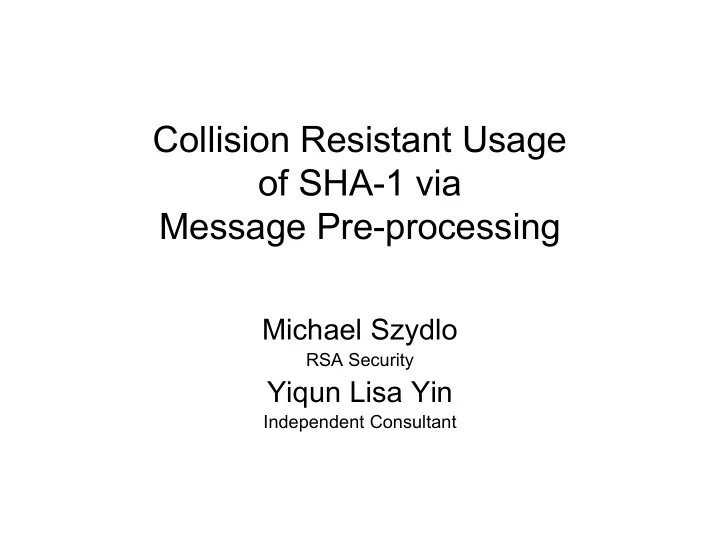

Collision Resistant Usage of SHA-1 via Message Pre-processing Michael Szydlo RSA Security Yiqun Lisa Yin Independent Consultant
Recent Advances in Hash Collision Attacks • Efficient collisions found for MD4, MD5 – Improved techniques include differential, message modification approaches – Other hash functions affected • Wang, Yin, Yu focus on full SHA-1 (2005) – Complexity of collision currently 2 69 – Compare to design goal of 2 80 • Security community planning response
Standard Track Response • Option #1: Upgrade hash function – Completely new hash function – Use SHA-256 – Truncate to SHA-256 output to 160 bits • Option #2: Re-design affected protocols – Incorporate randomness into hashing – Randomized Hashing (Halevi, Krawczyk) • H_r(m) = H(m XOR r||r||r…r) • RSASign(m) = (r,RSA(r,H_r(m))
Considerations • Upgrade Option – New hash function design takes years – Larger output of SHA-256 inconvenient – Security of “Truncated SHA-256” has not been explicitly studied • Randomized Hashing Option – Randomness is required and needs to be managed – Possible changes in signature size – Alter protocols such as PKCS#1
Message Pre-processing • A simple message transformation – M’ = _(M), _ is very simple function – New derived hash function is • SHApp(m) = SHA-1(_(M)) • Effects on applications – Prevents all known collision attacks – _ stretches message length 33-100%
Two Candidate Transformations • Message Whitening (word-wise) – m 1 m 2 m 3 m 4 m 5 … becomes – m 1 m 2 … m 12 0 0 0 0 m 13 m 14 … m 24 0 0 0 0 m 25… – Each block contains whitened words • Message Interleaving – m 1 m 2 m 3 m 4 m 5 … becomes – m 1 m 1 m 2 m 2 m 3 m 3 … – Each block contains duplicated words
Implementation Options • Pre-processing within SHA-1 Function – Change SHAUpdate() to SHAppUpdate() – New function SHAppUpdate() • expands m via _ • calls usual SHAUpdate() as black box • Pre-processing outside SHA-1 Function – Processing occurs first and then calls usual SHA-1 as black box • Two options are interoperable – Which option is better depends on the application
Implementation and Security Features • Zero “API signature” change – Output of SHApp(m) is automatically 160-bit • Almost zero change to protocol specification – Only need a new algorithm identifier for SHApp • Security analysis – Leverages on existing analysis of SHA-1 – Effects of pre-processing techniques can be quantified
Comparing Approaches Truncate SHA-256 Random Hash Preprocess √ Hash Output Truncation √ Change Signature Size √ Randomness Required √ Replace SHA1 Code Change Message √ √ before Hashing 33-100% 50-200% (not %) Depends Execution Cost Depends on SHA-256 Depends on whitening (time increase) slowdown on platform random generation parameter
Conclusions • Message preprocessing is viable solution to increasing secure life of SHA-1 • Technique can also be applied to MD5 • Long term solutions involve design of new hash function from the ground up • See paper for additional detail including security analysis – Submitted to NIST for inclusion in the Cryptographic Hash Workshop scheduled for 31-Oct-2005 – Available online at: http://eprint.iacr.org/2005/248
Recommend
More recommend